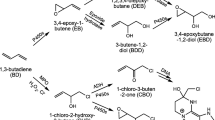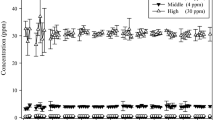Abstract
Male Wistar rats were exposed to thermo-oxidative degradation products of heated poly(acrylonitrile-butadiene-styrene) (ABS). The exposures were conducted once, three times or ten times (5 nights/week, 6 h/night) in the nighttime. The degradation products included styrene, various nitriles, aldehydes, acids, and a significant aerosol fraction. The oxygen concentration in the exposure chamber was constantly above 20%. The shortest exposures caused a significant reduction of the 0-deethylation activity in lung and kidney but not in liver, as well as a decrease in tissue reduced glutathione concentration in liver and kidney but not in lung. These effects well-nigh disappeared during the two-week exposure. In these rats the cerebral glutathione was below the control range. Superoxide dismutase activity increased in liver and brain during the three-day exposure. In liver the activity reached the control value after the two-week exposure but the cerebral activity was significantly lower than in controls. The complex mixture of noxious compounds in the ABS fumes does not readily allow identification of causative agents. Nitrile-dependent histotoxic, peroxidative and reactive metabolite mediated mechanisms may be involved.
Similar content being viewed by others
References
Aitio A (1974) Effect of chrysene and carbon tetrachloride on rat hepatic microsomal monooxygenase and UDP-glucuronosyltransferase activity. FEBS Lett 42: 46–49
Aitio A (1978) A simple and sensitive assay of 7-ethoxycoumarin deethylation. Anal Biochem 85: 488–491
Aitio A, Vainio H (1976) UDP-glucuronosyltransferase and mixed function oxidase activity in microsomes prepared by differential centrifugation and calcium aggregation. Acta Pharmacol Toxicol 39: 555–561
Bus JS, Aust SD, Gibson JE (1976) Paraquat toxicity: Proposed mechanism of action involving lipid peroxidation. Environ Health Perspect 16: 139–146
Cantrell ET, Abreu-Greenberg M, Guyden J, Busbee DL (1975) Metabolism of diphenyloxazole (PPO) by mouse liver microsomes. Life Sci 17: 317–322
Chasseaud LF (1976) Conjugation with glutathione and mercapturic acid excretion. In: Arias IM, Jakoby WB (eds) Glutathione: Metabolism and function. Raven Press, New York, p 77
Cohen JR, Altshuller AP (1961) A new spectrophotometric method for the determination of acrolein in combustion gases and in the atmosphere. Anal Chem 33: 726–733
Cuzner ML, Davison AN, Gregron NA (1965) The chemical composition of vertebrate myelin and microsomes. J Neurochem 12: 469–481
De Marchena O, Guarnieri M, McKhann G (1974) Glutathione peroxidase levels in brain. J Neurochem 22: 723–726
Einhorn IN (1975) Physiological and toxicological aspects of smoke produced during the combustion of polymeric materials. Environ Health Perspect 11: 163–189
Elovaara E, Savolainen H, Parkki MG, Aitio A, Vainio H (1977) Neurochemical effects of 2,3,7,8-tetrachlorodibenzo-p-dioxin in Wistar and Gunn rats. Res Commun Chem Pathol Pharmacol 18: 487–495
Fridovich I (1979) Hypoxia and oxygen toxicity. In: Fahns S, Davis JN, Rowland LP (eds) Cerebral hypoxia and its consequences. Adv Neurol 26:255
Goldman FH, Yagoda H (1943) Collection and estimation of traces of formaldehyde in air. Ind Eng Chem, Anal 15: 377–379
Hissin PJ, Hilf RA (1976) A fluorometric method for the determination of oxidized and reduced glutathione in tissues. Anal Biochem 74: 214–226
IARC (1979) International Agency for Research on Cancer, Lyon. IARC monographs on the evaluation of the carcinogenic risk of chemicals to humans. Some monomers, plastics, synthetic elastomers, and acrolein, vol 19, p 73
Isselbacher KJ (1956) Enzymatic mechanism of hormone metabolism. II: Mechanism of hormonal glucuronide formation. Recent Prog Horm Res 12: 134–145
Izard C, Libermann C (1978) Acrolein. Mutat Res 47: 115–138
Jacobsson S, Hoff A (1980) Degradation products of plastics. I: Polyethylene and styrene containing thermoplastics. Report for the reference group of the Swedish Work Environment Fund. Stockholm 17. 6. 1980
Johannesen KAM, DePierre JW (1978) Measurement of cytochrome P-450 in the presence of large amounts of contaminating hemoglobin and methemoglobin. Anal Biochem 86: 725–732
Lefaux R (1966) Chemie und Toxikologie der Kunststoffe. Krausskopf, Mainz, p 73
Lowry OH, Rosenbrough HJ, Farr AL, Randall RJ (1951) Protein measurement with the Folin phenol reagent. J Biol Chem 193: 265–275
Majewska D, Strosznajder J, Lazarewicz J (1978) Effect of ischemic anoxia and barbiturate anesthesia on free radical oxidation of mitochondrial phospholipids. Brain Res 158: 423–434
Marks N, Stern F, Lajtha A (1975) Changes in proteolytic enzymes and proteins during maturation of the brain. Brain Res 86: 307–322
Marshall MJ, Worsfold M (1978) Superoxide dismutase: A direct, continuous linear assay using the oxygen electrode. Anal Biochem 86: 561–573
Masuda Y, Murano T (1977) Carbon tetrachloride-induced lipid peroxidation of rat liver microsomes in vitro. Biochem Pharmacol 26: 2275–2282
Modern Plastics International (1979) More choices in ABS, vol 9, No 8, pp 8–11
Modern Plastics International (1980a) European materials market: Consumption up by 10% over 1980, vol 10, No 1, pp 22–24
Modern Plastics International (1980b) Materials 1980, vol 10, No 1, pp 37–43
Niosh (1972) American Public Health Association, Washington (NIOSH manual of analytical methods of air sampling and analysis), p 194
NIOSH (1975) American Public Health Association, Washington [NIOSH manual of analytical methods, HEW publication No. (NIOSH)], pp 75–121
Omura T, Sato R (1964) The carbon monoxide-binding pigment in liver: I. Evidence for its hemoprotein nature. J Biol Chem 239: 2370–2378
Paine AJ (1978) Exited states of oxygen in biology: Their possible involvement in cytochrome P450 linked oxidations as well as in the induction of the P450 system by many diverse compounds. Biochem Pharmacol 27: 1805–1813
Phillips A, Langdon RG (1962) Hepatic triphosphopyridine nucleotide-cytochrome c reductase: Isolation, characterization and kinetic studies. J Biol Chem 237: 2652–2660
Pfäffli P, Zitting A, Vainio H (1978) Thermal degradation products of homopolymer polystyrene in air. Scand J Work Environ Health (Suppl 2) 4: 22–27
Rehncrona S, Folbergrova J, Smith DS, Siesjö BK (1980) Influence of complete and pronounced incomplete cerebral ischemia and subsequent recirculation on cortical concentrations of oxidized and reduced glutathione in the rat. J Neurochem 34: 477–486
Saville B (1958) A scheme for the colorimetric determination of microgram amounts of thiols. Analyst 83: 670–672
Savolainen H, Tenhunen R, Elovaara E, Tossavainen A (1980) Cumulative biochemical effects of repeated subclinical hydrogen sulfide intoxication in mouse brain. Int Arch Occup Environ Health 46: 87–92
Vainio H, Mäkinen A (1977) Styrene and acrylonitrile induced depression of hepatic nonprotein sulfhydryl content in various rodent species. Res Commun Chem Pathol Pharmacol 17: 115–124
Vainio H, Järvisalo J, Taskinen E (1979) Adaptive changes caused by intermittent styrene inhalation on xenobiotic biotransformation. Toxicol Appl Pharmacol 49: 7–14
Watanabe PG, Hefner RE, Gehring PJ (1976) Vinyl chloride induced depression of hepatic non-protein sulfhydryl content and effects on bromosulphtalein (BSP) clearance in rats. Toxicology 6: 1–8
Zitting A, Pfäffli P, Vainio H (1978) Effects of thermal degradation products of polystyrene on drug biotransformation and tissue glutathione in rat and mouse. Scand J Work Environ Health (Suppl 2) 4: 60–66
Zitting A, Savolainen H (1979) Neurotoxic effects of the oxidative thermal degradation products from low density polyethylene. Fire Materials 3: 80–83
Zitting A, Heinonen T, Vainio H (1980) Glutathione depletion in isolated rat hepatocytes caused by styrene and the thermal degradation products of polystyrene. Chem Biol Interact 31: 313–318
Zitting A, Heinonen T (1980) Decrease of reduced glutathione in isolated rat hepatocytes caused by acrolein, acrylonitrile, and the thermal degradation products of styrene copolymers. Toxicology (in press)
Author information
Authors and Affiliations
Rights and permissions
About this article
Cite this article
Zitting, A., Savolainen, H. Effects of single and repeated exposures to thermo-oxidative degradation products of poly(acrylonitrile-butadiene-styrene) (ABS) on rat lung, liver, kidney, and brain. Arch Toxicol 46, 295–304 (1980). https://doi.org/10.1007/BF00310447
Received:
Issue Date:
DOI: https://doi.org/10.1007/BF00310447




